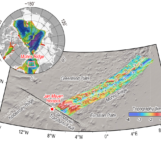
We are all studying geodynamics, but what does that really mean? Do we limit ourselves to the mantle? The lithosphere? The equations we solve? In this Wit & Wisdom post, Colin Hardy, PhD student in fluid dynamics at the University of Leeds, United Kingdom, makes his case for an often forgotten boundary condition of mantle geodynamicists: the core.
 Let us start with the basics and break down the word. The prefix “geo” is derived from the Greek word γη, meaning “Earth”. The term “dynamics” is the branch of mechanics concerned with the motion of bodies under the action of forces. Hence if someone unfamiliar with the field was to logically decipher it, they may conclude that it must represent the study of all motion throughout the Earth. However, I find that this is not what most geodynamicists mean when using the term. I still remember an interaction at one of my first conferences, a conversation with a self-styled geodynamcist, who studied mantle convection. They asked “do you also study geodynamics” and I recall the puzzled look that my apparently oxymoronic response “yes, I research core dynamics” yielded.
Let us start with the basics and break down the word. The prefix “geo” is derived from the Greek word γη, meaning “Earth”. The term “dynamics” is the branch of mechanics concerned with the motion of bodies under the action of forces. Hence if someone unfamiliar with the field was to logically decipher it, they may conclude that it must represent the study of all motion throughout the Earth. However, I find that this is not what most geodynamicists mean when using the term. I still remember an interaction at one of my first conferences, a conversation with a self-styled geodynamcist, who studied mantle convection. They asked “do you also study geodynamics” and I recall the puzzled look that my apparently oxymoronic response “yes, I research core dynamics” yielded.
I would not dream of disputing that mantle dynamics is an important part of geodynamics, but did I miss the news that Earth’s core is now no longer part of the Earth? After all, if we are being picky in terms of true dynamics, the core is of course a million times more dynamic than the mantle.
Maybe it is due to my mathematical background but I have always been a strong advocate of clear and universal definitions and therefore there is something that really sticks in my craw about core dynamics generally not being included within geodynamics, despite the core clearly being a subset of the Earth.
The origin of the mantle monopolisation of the term is unclear, I suspect that it is more likely to have been merely an unplanned unconscious evolution, that has been allowed to slowly creep in (although I should stress, slow compared to human timescales, not the ones of mantle “so-called” dynamics), as opposed to being the result of some mischievous or egotistical mantle dynamicists back in the day, scheming a cunning ‘define and conquer’ plan to make their field appear more significant. Perhaps it is one of these things that is just so ingrained now that the word has lost all previous meaning and evolved to its new one, however unintuitive that may be. After all this is a fundamental feature of language – its fluid dynamism, but I proclaim that not all evolution is assured to be positive and the metric for this in terms of language must surely be that clarity is king.
Some may say it does not matter, the term is now in place, well understood and should be maintained by tradition, but I retort that while tradition and conventions can have utility, the scientific world is littered with examples of poorly chosen definitions, which would be better overturned. From electric current travelling positive to negative despite electrons being negatively charged, to the definition of early-type and late-type stars, which has nothing to do with time. These definitions, based on misconceptions at the time, are now at best inconvenient and at worst downright misleading.
In the case of geodynamics the apparent ambiguity of the name may be unimportant to those in the field but I warn that it can be problematic as we attempt to engage with those outside our bubble. Hence I call on us as a geophysics community (which I note is a term used to refer to the entirety of Earth-related physics, not just the mantle, further highlighting the absurdity of the “dynamics” counterpart) to nip this in the substantial but not yet fully formed bud, before it becomes completely ingrained and is too late to concede that the core is indeed a dynamical part of the Earth.
Note from the editor: Ironically, the author has glossed over the enormous field of lithosphere dynamics, which is also a big part of geodynamics. Let me assure the readers that this blog is interested in all the dynamics of the Earth, be it core, mantle, or lithosphere (maybe not so much cloud dynamics, though). Interested in learning a bit more about core dynamics to see what all the fuss is about? You can read all about it in our Geodynamics 101 post about core dynamics: The world’s largest magnet.



